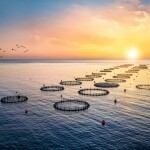Mortality figures at several Chilean salmon farms continue to climb due to a harmful algal bloom event that has recently affected operations in southern Chile’s Aysén region.
The bloom began 31 December 2023 and was originally reported 2 January 2024, when Chile’s National Fisheries and Aquaculture Service (Sernapesca) announced that the event had caused mortality impacting 2,854 metric tons (MT) of Atlantic and coho salmon. In its latest update from 9 January, that figure had risen to 4,994 MT.
“Of the five centers affected by the bloom event, one is still carrying out harvesting maneuvers to finish its production cycle, and the remaining four are without fish, ending the early harvest,” Jorge Padilla, acting regional director of Sernapesca Aysén, said. “This is a measure that aims to prevent new mass mortality in the event that concentrations of [microalgae genus] Pseudochattonella remain above harmful levels or increase. For our part, we will maintain surveillance in the surrounding farming centers and throughout the region.”
The five salmon farms – all of which are located northeast of Isla Victoria in Chile’s Aysén region – activated contingency plans due to the presence of the microalgae. Affected farms with mass mortality include AquaChile’s Melchor 7 Center and Blumar’s Victoria and Chivato 1 centers, while farms belonging to MultiX and Mowi underwent monitoring.
The total biomass in the affected concession area amounts to ...
Photo courtesy of Shutterstock/smspsy








